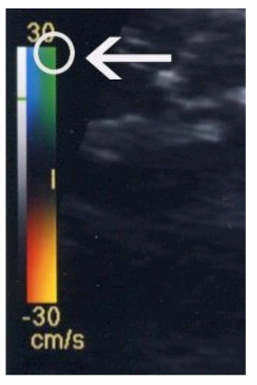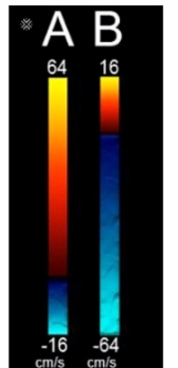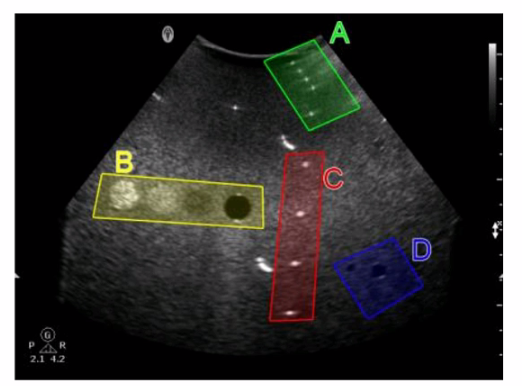What is effected by increasing the color scale?
A. The Nyquist limit is increased
B. More colors are displayed
C. The color box width decreases
D. The color priority decreases
Explanation: The Nyquist limit, which is the maximum detectable velocity before aliasing occurs, is directly related to the pulse repetition frequency (PRF). Increasing the color scale on the ultrasound machine effectively increases the PRF. When the PRF is increased, the Nyquist limit is also increased, allowing for the measurement of higher velocities without aliasing.
Which parameters determine the propagation speed of sound in a medium?
A. Frequency and impedance
B. Amplitude and impedance
C. Intensity and density
D. Elasticity and density
Explanation: The propagation speed of sound in a medium is determined by the medium's elasticity and density. Elasticity refers to the ability of the medium to return to its original shape after deformation, while density is the mass per unit volume of the medium. The speed of sound increases with higher elasticity and decreases with higher density. This relationship is described by the equation =v=E, where v is the propagation speed, E is the elasticity (or modulus of elasticity), and is the density.
Which method of sanitizing the transducer would damage piezoelectric crystals?
A. Bleach
B. Glutaraldehyde
C. Alcohol
D. Autoclave
Explanation: Autoclaving involves high-pressure steam at high temperatures, which can damage the delicate piezoelectric crystals within the ultrasound transducer. These crystals are responsible for converting electrical energy into sound waves and vice versa. Exposure to the extreme conditions of an autoclave can cause thermal and mechanical damage to the crystals, rendering the transducer ineffective.
Which action would increase the frame rate?
A. Increasing the sector width
B. Increasing the number of lines per frame
C. Decreasing the logarithmic compression
D. Decreasing the number of focal zones
Explanation: The frame rate in ultrasound imaging is influenced by several factors, including the number of focal zones. Each focal zone requires additional transmission and reception cycles, thus decreasing the frame rate. By decreasing the number of focal zones, the system requires fewer cycles per frame, which increases the frame rate. This enhances the temporal resolution, making it easier to capture fast-moving structures in real-time imaging.
In this image, which characteristics of flow are represented by the upper right side of a variance mode color map?

A. Higher velocity, laminar with a positive Doppler shift
B. Higher velocity, laminar with a negative Doppler shift
C. Higher velocity, turbulent with a positive Doppler shift
D. Higher velocity, turbulent with a negative Doppler shift
Explanation: In a variance mode color map, the upper right side typically indicates higher velocity and turbulent flow with a positive Doppler shift. Variance mode maps are designed to display not only the mean velocity and direction of blood flow but also the presence of turbulence. The color green is often used in the upper right quadrant to represent areas of turbulence with positive Doppler shifts, which occur when the blood flow is moving towards the transducer at higher velocities and with increased chaotic motion.
Which factor influences color flow imaging frame rate?
A. Filter selection
B. Dynamic range
C. Line density
D. Variance map selection
Explanation: The frame rate in color flow imaging is influenced by several factors, one of the most significant being line density. Line density refers to the number of ultrasound lines used to create an image. Increasing line density improves spatial resolution but requires more time to acquire each frame, thereby reducing the frame rate. Other factors such as filter selection, dynamic range, and variance map selection can affect the quality of the color flow image, but they do not have as direct an impact on frame rate as line density does.
Which outcome is an advantage of more pulses in an ensemble length?
A. Reduced ghosting artifact
B. Increased accuracy of velocity measurement
C. Improved temporal resolution
D. Increased line density
Explanation: Ensemble length, also known as packet size or Doppler packet, refers to the number of pulses used to calculate each Doppler measurement. Increasing the number of pulses in an ensemble length improves the accuracy of velocity measurements by providing more data points for the Doppler shift analysis. This leads to better estimation of mean velocities and reduces the variability of the measurements, although it may slightly decrease temporal resolution due to the longer time required to acquire the data.
Which factor causes posterior acoustic enhancement?
A. High-frequency transducer
B. Low-frequency transducer
C. Strongly attenuating structure
D. Weakly attenuating structure
Explanation:
What information does the ultrasound system calculate to display color flow?
A. Peak Doppler frequency
B. Mean Doppler frequency
C. Peak velocity of flow
D. Minimum velocity of flow
Explanation:
Color flow Doppler imaging displays the mean Doppler frequency shift, which represents
the average velocity of blood flow within a sample volume. The ultrasound system uses
autocorrelation to process Doppler signals and compute the mean frequency shift. This
provides a color-coded map of blood flow velocities, allowing for visualization of flow
direction and speed. The mean Doppler frequency is displayed as different colors, with
each color representing a range of velocities.
Which color control was adjusted in color bar A to produce color bar B?

A. Baseline
B. Scale
C. Map
D. Invert
Explanation: The color bar on a Doppler ultrasound display indicates the range of velocities that the system can detect and display. In color bar A, the scale is set to a higher maximum velocity (64 cm/s), while in color bar B, the scale is set to a lower maximum velocity (16 cm/s). Adjusting the scale (or velocity range) changes the upper and lower limits of the velocities displayed, which affects the sensitivity of the Doppler system to detect flow velocities. Lowering the scale allows for better visualization of lower velocities, but it may also increase the likelihood of aliasing for higher velocities.
Which target group in this image of a tissue-mimicking phantom is used for gray-scale evaluation?

A. Option A
B. Option B
C. Option C
D. Option D
Explanation:
Gray-scale evaluation in a tissue-mimicking phantom involves assessing the
uniformity and accuracy of the gray-scale representation of the tissues.
Option C typically contains structures designed to test the machine's ability to
accurately depict varying levels of echogenicity, which is essential for proper grayscale
evaluation.
This area will have a range of echo intensities that help in determining the contrast
resolution and the ability of the system to distinguish between different tissue types
based on their gray-scale values.
Which color Doppler setting can be optimized to eliminate low-frequency Doppler shifts without having any effect on higher Doppler frequency shifts?
A. Gain
B. Scale
C. Wall filter
D. Persistence
Explanation: The wall filter is used in color Doppler and spectral Doppler imaging to eliminate low-frequency Doppler shifts caused by tissue motion or vessel wall movement. Adjusting the wall filter removes these low-frequency signals without affecting higher frequency Doppler shifts that represent blood flow. Other settings like gain, scale, and persistence do not selectively filter out low-frequency shifts in the same manner.
| Page 1 out of 9 Pages |